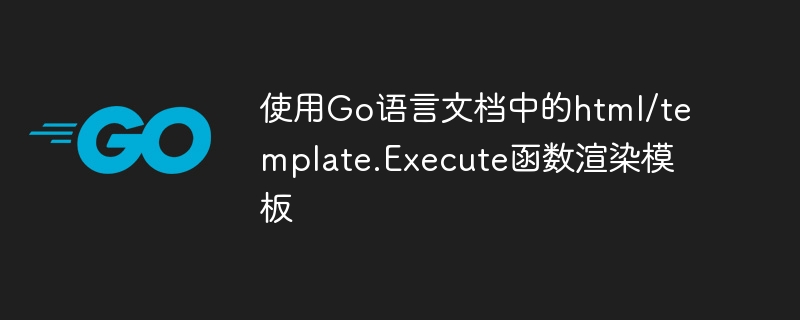

Use the html/template.Execute function in the Go language documentation to render the template. Specific code examples are required
In the development of web applications, the template engine is a very important The important part. The template engine can output the final HTML page by merging the template file with the data. At the same time, the template engine can separate dynamic data from HTML pages, making the application easier to maintain and expand. The template engine of the Go language is very powerful and is widely used in actual projects.
The Go language provides many powerful template engines, the most commonly used of which is the html/template template engine. Its advantage is that it can well avoid cross-site scripting attacks, and its use is relatively simple and easy to master.
This article will use a specific example to demonstrate how to use the html/template.Execute function to render a template.
Example description:
We assume a simple application. In this application, we need to store the data in the form submitted by the user into the database and output a response page. This response page has the following requirements:
In order to achieve the above purpose, we first need to create an HTML template, as shown below:
<!doctype html>
<html>
<head>
<meta charset="UTF-8">
<title>提交成功</title>
</head>
<body>
<h2>您提交的数据如下:</h2>
<p>姓名: {{.Name}}</p>
<p>性别: {{.Gender}}</p>
<p>年龄: {{.Age}}</p>
<h3>提交成功!</h3>
</body>
</html>In the above HTML template, we used {{.Name}}, The three variables {{.Gender}} and {{.Age}} will be replaced with user-submitted data when the template is rendered.
Let’s take a look at how to use the html/template.Execute function in the Go language for template rendering.
package main
import (
"html/template"
"net/http"
)
type UserInfo struct {
Name string
Gender string
Age int
}
func main() {
http.HandleFunc("/", handleRequest)
http.ListenAndServe(":8888", nil)
}
func handleRequest(w http.ResponseWriter, r *http.Request) {
if r.Method == "POST" {
// 解析表单数据
r.ParseForm()
// 获取表单数据
name := r.FormValue("name")
gender := r.FormValue("gender")
age := r.FormValue("age")
// 生成数据模型
userInfo := UserInfo{
Name: name,
Gender: gender,
Age: age,
}
// 解析模板文件
tmpl, err := template.ParseFiles("template.html")
if err != nil {
http.Error(w, err.Error(), http.StatusInternalServerError)
return
}
// 将数据和模板渲染
err = tmpl.Execute(w, userInfo)
if err != nil {
http.Error(w, err.Error(), http.StatusInternalServerError)
}
return
}
// 读取表单页面
http.ServeFile(w, r, "form.html")
}In the above code, we first define a UserInfo structure, which contains the data submitted by the user. In the handleRequest function, first determine whether it is a POST request. If it is a POST request, first parse the form data, then generate a UserInfo data model, and render it together with the template file to generate the final HTML page.
In the process of rendering the template, we first load our template file through the template.ParseFiles function, and then call the tmpl.Execute function to merge the data and template for output. If an error occurs while rendering the template, we use the http.Error function to return the error message to the client.
Finally, if it is not a POST request, we will read the form page (form.html) and return it to the client.
Summary:
Through the above code example, we can see that it is very easy to use the html/template.Execute function to render a template. Just merge the data model and template files, and then output the final HTML page through the Execute function.
html/template The method of using the template engine can be said to be very simple and flexible. As a cross-platform application development language, the design of Go language in terms of template engine is also very excellent. Whether you are developing a high-performance website or some small applications, using the html/template template engine is a good choice.
The above is the detailed content of Render templates using the html/template.Execute function in the Go language documentation. For more information, please follow other related articles on the PHP Chinese website!
 Usage of Type keyword in Go
Usage of Type keyword in Go
 How to implement linked list in go
How to implement linked list in go
 What are the Go language programming software?
What are the Go language programming software?
 How to learn go language from 0 basics
How to learn go language from 0 basics
 What are the methods to implement operator overloading in Go language?
What are the methods to implement operator overloading in Go language?
 What are the operators in Go language?
What are the operators in Go language?
 How to use the decode function
How to use the decode function
 Delete redundant tables in the table
Delete redundant tables in the table




